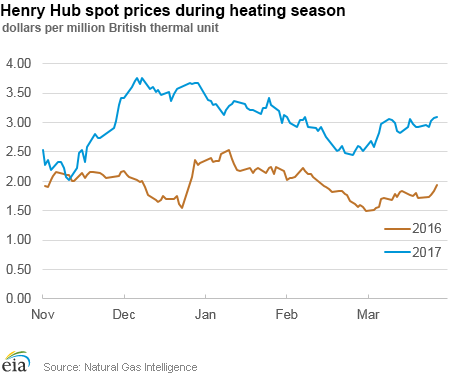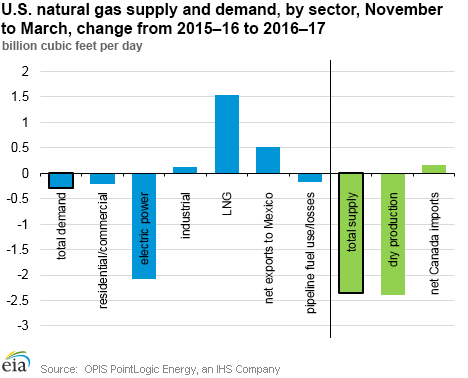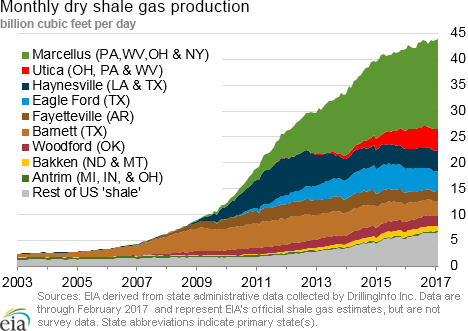In the News:
Heating season spot prices in 2016–17 averaged 52% higher than in 2015–16
U.S. benchmark natural gas spot prices at the Henry Hub averaged $3.01 per million British thermal unit (MMBtu) during the 2016–17 season, 52% ($1.03) higher than prices during the same period in 2015–16. Henry Hub spot prices began the 2016–17 season closer to last year's levels, around $2.00–$2.50/MMBtu. Both years began the heating season with historically high levels of working natural gas in storage, which typically puts downward pressure on prices.
In 2016, prices rose rapidly during the second half of November and first week in December, compared with the relatively flat prices at the same time in 2015. December 2016 spot prices at the Henry Hub averaged more than $3.50/MMBtu compared with $1.98/MMBtu in 2015, as weather that was colder than in December 2015 pushed up heating demand.
Henry Hub spot prices fell back below $3.50/MMBtu in January 2017 as temperatures warmed, and declined further during the second-warmest February on record. However, January and February 2016 were also warmer than normal. In 2016, the Henry Hub spot price remained below $2.00/MMBtu for the latter half of February and all of March 2016. March 2017 prices averaged $2.87/MMBtu and ended the month at $3.10, more than a dollar higher than the March 2016 closing price of $1.93/MMBtu.
During the 2016–17 heating season, total natural gas demand was near the same level as the 2015–16 heating season, with year-over-year decreases in power burn roughly offset by increases in U.S. exports, according to data from PointLogic. However, natural gas production in the Lower 48 states during the 2016–17 heating season averaged over 2 billion cubic feet per day (Bcf/d) below production in the 2015–16 season. With imports of Canadian natural gas averaging 0.2 Bcf/d above last year, most of this supply shortfall was met by withdrawing greater volumes of natural gas from storage.
Natural gas inventories ended the heating season (November 1 through March 31) at 2,051 billion cubic feet (Bcf), 427 Bcf less than the previous year, but 265 Bcf more than the five-year (2012–16) average, according to EIA's Weekly Natural Gas Storage Report. Net withdrawals from storage since November 1, 2016 totaled 1,935 Bcf, 32% higher than last year's withdrawals of 1,468 Bcf.
Overview:
(For the Week Ending Wednesday, April 5, 2017)
- Natural gas spot prices rose at most locations this report week (Wednesday, March 29 to Wednesday, April 5). The Henry Hub spot price rose from $3.03 per million British thermal units (MMBtu) last Wednesday to $3.21/MMBtu yesterday.
- At the New York Mercantile Exchange (Nymex), the April 2017 contract expired last Wednesday at $3.175/MMBtu. The May 2017 contract price increased to $3.266/MMBtu, up 4¢ Wednesday to Wednesday.
- Net injections to working gas totaled 2 Bcf for the week ending March 31. Working natural gas stocks are 2,051 Bcf, which is 17% less than the year-ago level and 15% greater than the five-year (2012–16) average for this week.
- The natural gas plant liquids composite price at Mont Belvieu, Texas, rose by 25¢, averaging $6.05/MMBtu for the week ending April 5. Spot prices for natural gasoline, ethane, and propane rose by 3%, 7%, and 6%, respectively. Spot prices for butane and isobutane remained flat week over week.
- According to Baker Hughes, for the week ending Friday, March 31, the natural gas rig count increased by 5 to 160, and the number of oil-directed rigs rose by 10 to 662. The total rig count increased by 15, and it now stands at 824. The natural gas rig count is currently 72 units, or 82%, higher than at the start of April last year, and the oil-directed rig count is 300 units, or 83%, higher than last year.
Prices/Supply/Demand:
Prices up across the nation. This report week (Wednesday, March 29 to Wednesday, April 5), the Henry Hub spot price rose 18¢ from $3.03/MMBtu last Wednesday to $3.21/MMBtu yesterday.
Over the report period, prices at the Chicago Citygate increased 21¢ to $3.24/MMBtu yesterday. Prices at PG&E Citygate in Northern California gained 19¢ to $3.39/MMBtu yesterday. The price at SoCal Citygate rose 31¢ to $3.32/MMBtu yesterday.
Late in the report week, temperatures fell in the Northeast and in the western half of the country, which generally pushed natural gas prices up. According to trade press, price increases on Tuesday and yesterday can be attributed to various factors, including near-term colder weather, nuclear outages, strong electric-sector demand, and strong export demand.
Northeast prices rise. At the Algonquin Citygate, which serves Boston-area consumers, prices went up 17¢ over the report week, settling at $3.23/MMBtu yesterday. Algonquin reached an intraweek high of $3.75 on Tuesday.
At the Transcontinental Pipeline Zone 6 trading point for New York, prices increased 21¢ from $2.93/MMBtu last Wednesday to $3.14/MMBtu yesterday.
Tennessee Zone 4 Marcellus spot prices advanced 32¢ for the report period, to $3.00/MMBtu yesterday. Prices at Dominion South in Northwest Pennsylvania rose 24¢ over the period, to $3.00/MMBtu yesterday.
April contract expires; May contract rises. At the Nymex, the April 2017 contract expired last Wednesday at $3.175/MMBtu. The May 2017 contract increased to $3.266/MMBtu, up 4¢ from last Wednesday to yesterday. The price of the 12-month strip, which averages May 2017 through April 2018 futures contracts, climbed 5¢ to $3.431/MMBtu.
Supply flat. According to data from PointLogic, the average total supply of natural gas remained the same as the previous report week, averaging 75.6 Bcf/d. Dry natural gas production remained constant week over week. Average net imports from Canada increased by 2% from last week.
Consumption falls slightly. Total U.S. consumption of natural gas fell by 2% compared with the previous report week, according to data from PointLogic. Week over week, power burn climbed by 5%; industrial sector consumption stayed flat at 20.9 Bcf/d; and residential and commercial sector consumption declined by 11%. Natural gas exports to Mexico increased 3% from last week.
U.S. liquefied natural gas (LNG) exports. Natural gas pipeline deliveries to the Sabine Pass liquefaction terminal averaged 2.1 Bcf/d for the report week, 14% higher than in the previous week. Five vessels (combined LNG-carrying capacity of 17.5 Bcf) departed Sabine Pass last week (Thursday to Wednesday) and one vessel (LNG-carrying capacity of 3.6 Bcf) was loading at the terminal on Wednesday, April 5.
Dominion Cove Point, another U.S. liquefaction facility currently under construction, announced in its latest monthly construction status report filed with the Federal Energy Regulatory Commission (FERC) that the facility is 80% complete. The facility operator, Dominion Cove Point LLC, requested FERC's permission to introduce feed gas and begin commissioning activities on the two auxiliary boilers and related support systems. The facility is expected to become operational by the end of 2017.
Storage:
Warmer temperatures during the final storage week of the heating season result in small net injections into working gas storage. Net injections into storage totaled 2 Bcf, compared with the five-year (2012–16) average net withdrawal of 13 Bcf and last year's net injections of 6 Bcf during the same week. Withdrawals from working gas totaled 150 Bcf during the previous storage week, as most of the Lower 48 states were significantly colder than normal. Working gas stocks total 2,051 Bcf, which is 265 Bcf more than the five-year average and 427 Bcf less than last year at this time.
Net 2 Bcf injection driven primarily by the South Central region and the Pacific region. Net injections in the South Central region and the Pacific region led to net injections in the Lower 48 states. Net injections of 4 Bcf in the Pacific region topped its five-year average by 2 Bcf. Net injections into working gas in the South Central region totaled 14 Bcf, exceeding the five-year average by 10 Bcf. Nonsalt facilities accounted for 7 Bcf of the net increase, and 8 Bcf of the swing compared with the 1 Bcf five-year average withdrawal in the region.
Withdrawals continued in the East and Midwest. Withdrawals in the East region and the Midwest region totaled 10 Bcf and 7 Bcf, compared with their five-year averages in both regions of 10 Bcf. Warming temperatures in the Midwest likely contributed to the smaller-than-average net withdrawals. The Middle Atlantic region also posted warmer-than-normal temperatures, while the New England temperatures remained colder than normal. As a result, net withdrawals in the East region matched the five-year average.
Natural gas market conditions during the storage week were supportive of net injections into working gas. During the most recent storage week, the average natural gas spot price at the Henry Hub was $2.98/MMBtu, 92¢ lower than the front-month futures price at the Nymex. A year ago, the spot price was 12¢ lower than the front-month contract.
Reported net injections fell below the range of market expectations for the week. According to the Bloomberg survey of natural gas analysts, estimates of net injections to working natural gas storage ranged from 4 Bcf to 15 Bcf. The price of the Nymex futures contract for May 2017 delivery at Henry Hub increased 3¢/MMBtu to $3.32/MMBtu in 920 trades at the release of the Weekly Natural Gas Storage Report (WNGSR). Prices varied in subsequent trading, reaching $3.33/MMBtu, before declining.
Temperatures are higher than normal in the Lower 48 states, on average. Temperatures in the Lower 48 states averaged 53°F, 5°F higher than the normal and 3°F higher than last year at this time. Temperatures were warmer than normal in most areas of the Lower 48 states, outside of the New England region. Temperatures in the New England Census division averaged 37°F, 3°F lower than the normal and 6°F lower than last year at this time. However, temperatures were considerably warmer than normal in the East and West South Central Census divisions. Temperatures in the East South Central Census division averaged 64°F, 10°F higher than the normal and 8°F higher than last year at this time. Temperatures in the West South Central Census division averaged 67°F, 7°F higher than the normal and 7°F higher than last year at this time. Temperatures in the South Atlantic Census division averaged 61°F, 7°F higher than the normal and 1°F higher than last year at this time.
See also:
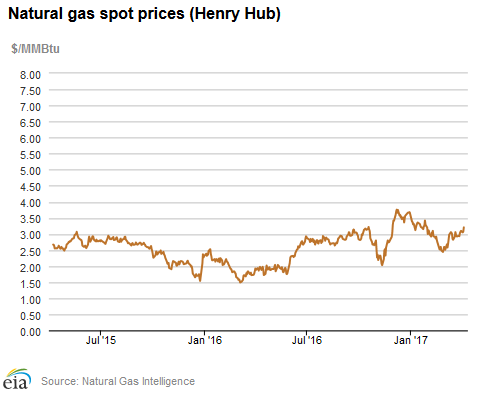
| Spot Prices ($/MMBtu) | Thu, 30-Mar |
Fri, 31-Mar |
Mon, 03-Apr |
Tue, 04-Apr |
Wed, 05-Apr |
|---|---|---|---|---|---|
| Henry Hub |
3.07 |
3.10 |
3.05 |
3.07 |
3.21 |
| New York |
2.93 |
2.90 |
2.85 |
2.92 |
3.14 |
| Chicago |
3.00 |
2.94 |
2.99 |
3.15 |
3.24 |
| Cal. Comp. Avg.* |
2.83 |
2.81 |
2.87 |
2.80 |
2.87 |
| Futures ($/MMBtu) | |||||
| May Contract | 3.191 |
3.190 |
3.128 |
3.293 |
3.266 |
| June Contract |
3.257 |
3.254 |
3.204 |
3.365 |
3.344 |
| *Avg. of NGI's reported prices for: Malin, PG&E Citygate, and Southern California Border Avg. | |||||
| Source: NGI's Daily Gas Price Index | |||||
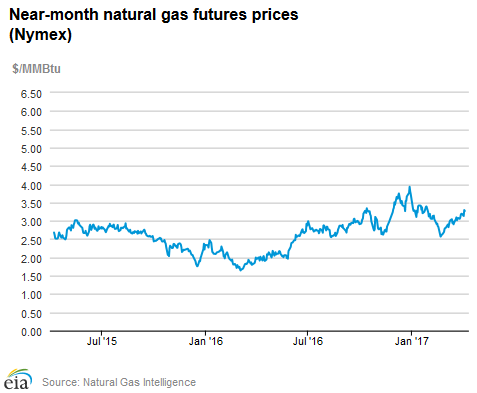
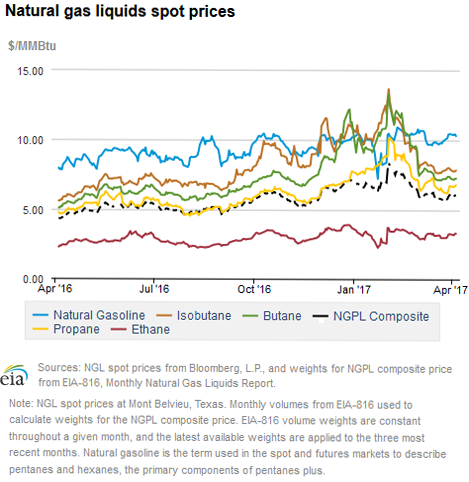
| U.S. natural gas supply - Gas Week: (3/30/17 - 4/5/17) | |||
|---|---|---|---|
Average daily values (Bcf/d): |
|||
this week |
last week |
last year |
|
| Marketed production | 78.4 |
78.3 |
81.3 |
| Dry production | 69.9 |
69.8 |
72.8 |
| Net Canada imports | 5.6 |
5.6 |
5.2 |
| LNG pipeline deliveries | 0.0 |
0.0 |
0.2 |
| Total supply | 75.6 |
75.4 |
78.3 |
|
Source: OPIS PointLogic Energy, an IHS Company | |||
| U.S. natural gas consumption - Gas Week: (3/30/17 - 4/5/17) | |||
|---|---|---|---|
Average daily values (Bcf/d): |
|||
this week |
last week |
last year |
|
| U.S. consumption | 62.5 |
63.8 |
66.6 |
| Power | 22.9 |
21.8 |
22.8 |
| Industrial | 20.9 |
20.9 |
21.0 |
| Residential/commercial | 18.7 |
21.1 |
22.8 |
| Mexico exports | 3.9 |
3.8 |
3.3 |
| Pipeline fuel use/losses | 6.2 |
5.6 |
6.4 |
| LNG pipeline receipts | 2.1 |
1.8 |
0.7 |
| Total demand | 74.6 |
75.0 |
77.0 |
|
Source: OPIS PointLogic Energy, an IHS Company | |||
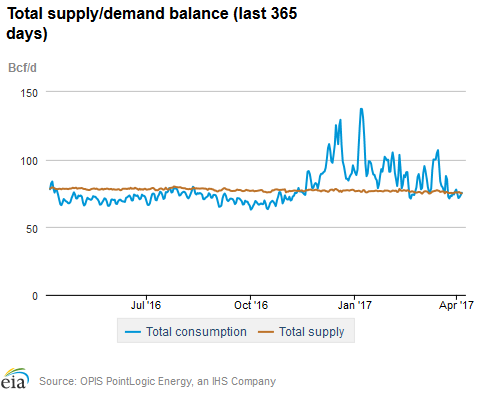
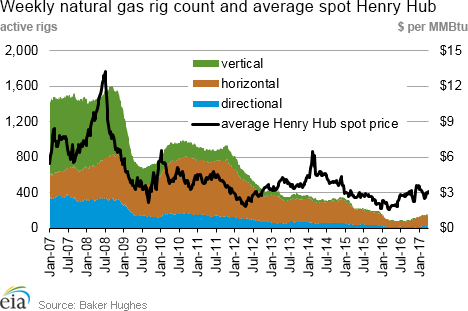
| Rigs | |||
|---|---|---|---|
Fri, March 31, 2017 |
Change from |
||
last week |
last year |
||
| Oil rigs | 662 |
1.5% |
82.9% |
| Natural gas rigs | 160 |
3.2% |
81.8% |
| Note: Excludes any miscellaneous rigs | |||
| Rig numbers by type | |||
|---|---|---|---|
Fri, March 31, 2017 |
Change from |
||
last week |
last year |
||
| Vertical | 69 |
-11.5% |
25.5% |
| Horizontal | 685 |
1.8% |
98.0% |
| Directional | 70 |
20.7% |
42.9% |
| Source: Baker Hughes Inc. | |||
| Working gas in underground storage | ||||
|---|---|---|---|---|
Stocks billion cubic feet (Bcf) |
||||
| Region | 2017-03-31 |
2017-03-24 |
change |
|
| East | 268 |
278 |
-10 |
|
| Midwest | 479 |
486 |
-7 |
|
| Mountain | 142 |
141 |
1 |
|
| Pacific | 216 |
212 |
4 |
|
| South Central | 946 |
932 |
14 |
|
| Total | 2,051 |
2,049 |
2 |
|
| Source: U.S. Energy Information Administration | ||||
| Working gas in underground storage | |||||
|---|---|---|---|---|---|
Historical comparisons |
|||||
Year ago (3/31/16) |
5-year average (2012-2016) |
||||
| Region | Stocks (Bcf) |
% change |
Stocks (Bcf) |
% change |
|
| East | 435 |
-38.4 |
332 |
-19.3 |
|
| Midwest | 549 |
-12.8 |
372 |
28.8 |
|
| Mountain | 149 |
-4.7 |
121 |
17.4 |
|
| Pacific | 265 |
-18.5 |
229 |
-5.7 |
|
| South Central | 1,081 |
-12.5 |
731 |
29.4 |
|
| Total | 2,478 |
-17.2 |
1,786 |
14.8 |
|
| Source: U.S. Energy Information Administration | |||||
| Temperature – heating & cooling degree days (week ending Mar 30) | ||||||||
|---|---|---|---|---|---|---|---|---|
HDD deviation from: |
CDD deviation from: |
|||||||
| Region | HDD Current |
normal |
last year |
CDD Current |
normal |
last year |
||
| New England | 193 |
17 |
42 |
0 |
0 |
0 |
||
| Middle Atlantic | 143 |
-18 |
26 |
0 |
0 |
0 |
||
| E N Central | 113 |
-54 |
-32 |
0 |
0 |
0 |
||
| W N Central | 128 |
-35 |
-27 |
0 |
-1 |
0 |
||
| South Atlantic | 44 |
-45 |
-9 |
19 |
7 |
0 |
||
| E S Central | 21 |
-63 |
-44 |
14 |
9 |
14 |
||
| W S Central | 16 |
-31 |
-32 |
33 |
19 |
22 |
||
| Mountain | 119 |
-22 |
-29 |
2 |
-2 |
0 |
||
| Pacific | 77 |
-5 |
4 |
0 |
-1 |
0 |
||
| United States | 95 |
-31 |
-12 |
8 |
3 |
3 |
||
|
Note: HDD = heating degree day; CDD = cooling degree day Source: National Oceanic and Atmospheric Administration | ||||||||
Average temperature (°F)
7-Day Mean ending Mar 30, 2017
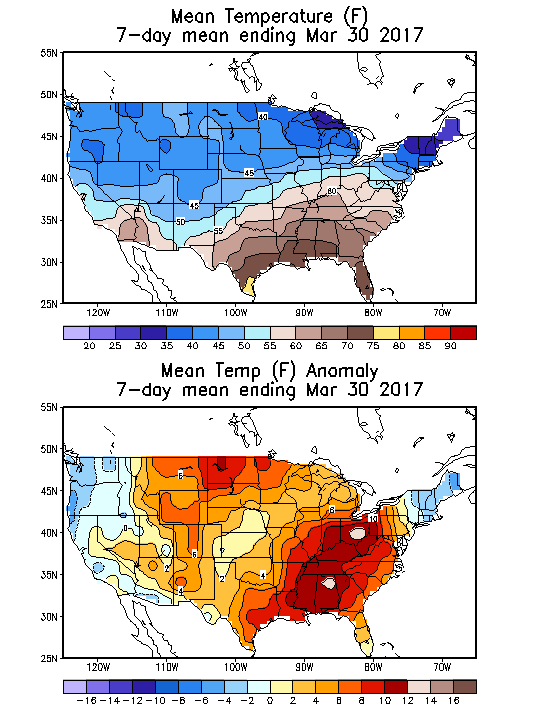
Source: NOAA National Weather Service
Deviation between average and normal (°F)
7-Day Mean ending Mar 30, 2017

Source: NOAA National Weather Service

